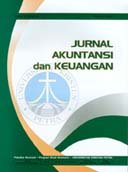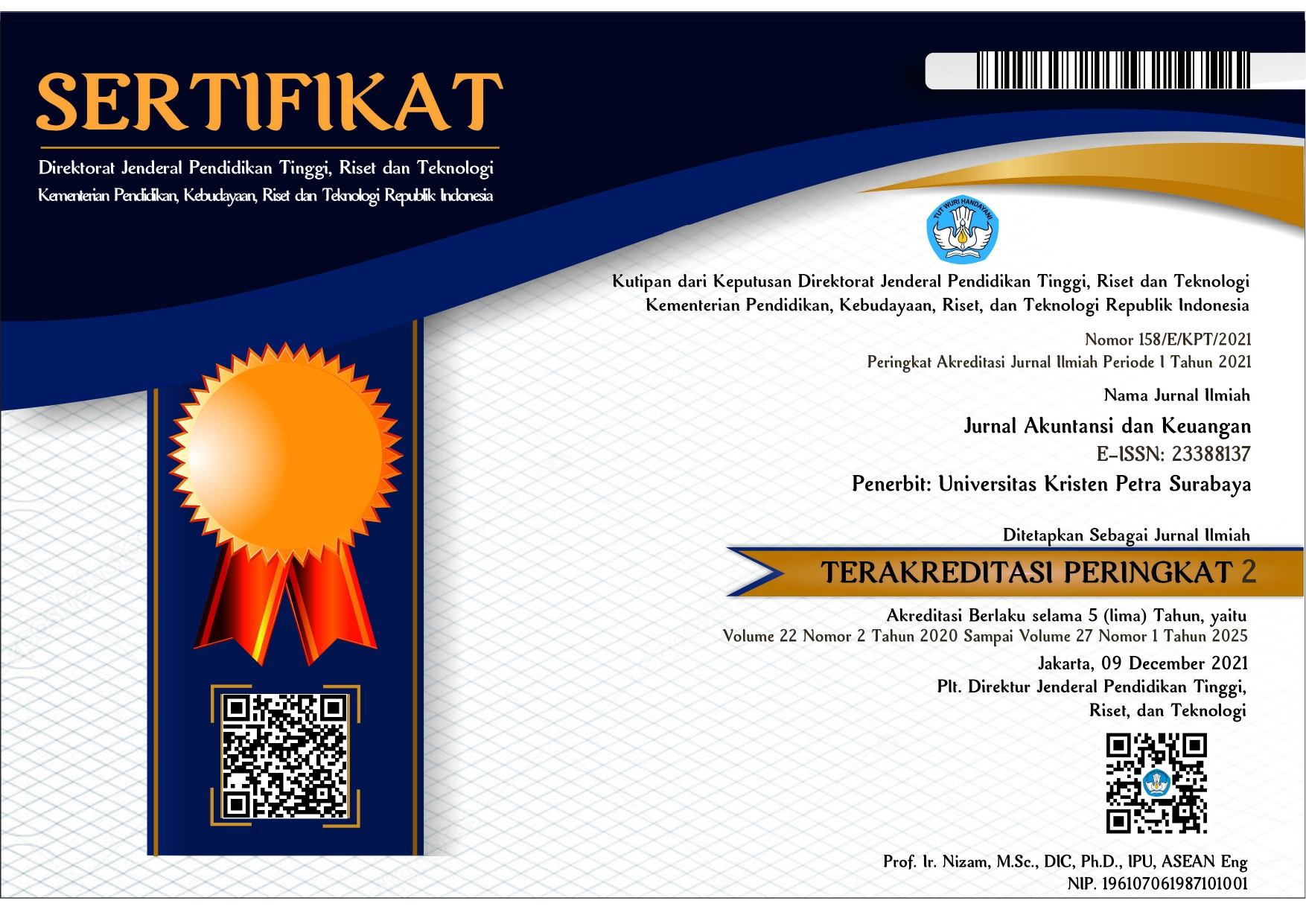The Impact of Corporate Governance Quality on Principal-Agent and Principal-Principal Conflict in Indonesia
DOI:
https://doi.org/10.9744/jak.24.2.91-105Keywords:
Corporate Governance Quality, Agency Conflict; Endogeneity, Two-Stage Least Squares.Abstract
This study analyzes the effect of corporate governance (CG) quality on principal-agent (PA) and principal-principal (PP) conflict in Indonesia while also controlling for potential endogeneity through the use of two-stage least squares (2SLS) regression. The results for PA conflict (measured by operating expense ratio and asset utilization ratio) are consistent with the notion that better CG quality leads to a lower level of PA conflict. However, the result for PP conflict is inconclusive. While a higher CG quality is positively related to a higher dividend payout ratio, which indicates a lower PP conflict level, CG quality does not have any significant effect on wedge (difference between cash flow and control right). Moreover, further robustness tests showed that different aspects of CG have different effects on PA and PP conflict. Better CSR has a significant effect on reducing PA and PP conflict. Meanwhile, asset utilization ratio and dividend payout ratio increase due to board efficiency, internal control management, and board remuneration. Furthermore, better internal control management also leads to a lower operating expense ratio, while board remuneration reduces wedge. Interestingly, we find no significant relationship between shareholders' relation and all PA and PP conflict measures.
References
Abbadi, S. S., Hijazi, Q. F., & Al-Rahahleh, A. S. (2016). Corporate governance quality and earnings management: Evidence from Jordan. Australasian Accounting, Business and Finance Journal, 10(2), 54-75.
Abor, J., & Fiador, V. (2013). Does corporate governance explain dividend policy in Sub‐Saharan Africa? International Journal of Law and Management.
Adel, C., Hussain, M. M., Mohamed, E. K., & Basuony, M. A. (2019). Is corporate governance relevant to the quality of corporate social responsibility disclosure in large European companies? International Journal of Accounting & Information Management.
Al-ahdad, W. M., Alsamhi, M. H., Tabash, M. I., & Farhan, N. H. (2020). The impact of corporate governance on financial performance of Indian and GCC listed firms: An empirical investigation. Research in International Business and Finance, 51, 101083.
Ali, S., Liu, B., & Su, J. J. (2018). Does corpo¬rate governance quality affect default risk? The role of growth opportunities and stock liquidity. International Review of Economics & Finance, 58, 422-448.
Allam, B. S. (2018). The impact of board characteristics and ownership identity on agency costs and firm performance: UK evidence. Corporate Governance: The International Journal of Business in Society.
Ang, J. S., Cole, R. A., & Lin, J. W. (2000). Agency costs and ownership structure. The Journal of Finance, 55(1), 81-106.
Ariyono, B. D., & Setiyono, B. (2020). Does Institutional Ownership and Bank Monitoring Affect Agency Conflicts? Evidence from an Emerging Market. Journal of Indonesian Economy and Business (JIEB), 35(3), 171-187.
Bhatt, P. R., & Bhatt, R. R. (2017). Corporate governance and firm performance in Malaysia. Corporate Governance: The International Journal of Business in Society.
Butar, S. B. (2019) Board of Commisioners Composition, Governance Committee, and Stock Price Synchronicity. Jurnal Akuntansi Dan Keuangan, 21, 1-11.
Butar, S. B. (2020) The Effects of Corporate Governance, Audit Quality, and Conservatism on Loan Collateral Requirements. Jurnal Akuntansi dan Keuangan, 22, 28-39.
Chen, F., Huyghebaert, N., Lin, S., & Wang, L. (2019). Do multiple large shareholders reduce agency problems in state-controlled listed firms? Evidence from China. Pacific-Basin Finance Journal, 57, 101203.
Ciftci, I., Tatoglu, E., Wood, G., Demirbag, M., & Zaim, S. (2019). Corporate governance and firm performance in emerging markets: Evidence from Turkey. International Business Review, 28(1), 90-103.
Christiani, I. & Nugrahanti, Y. W. (2014) Pengaruh Kualitas Audit Terhadap Manajemen Laba. Jurnal Akuntansi dan Keuangan, 16, 52-62.
Crisóstomo, V. L., de Freitas Brandão, I., & López-Iturriaga, F. J. (2020). Large shareholders' power and the quality of corporate governance: An Analysis of Brazilian firms. Research in International Business and Finance, 51, 101076.
Detthamrong, U., Chancharat, N., & Vithessonthi, C. (2017). Corporate governance, capital structure and firm performance: Evidence from Thailand. Research in International Business and Finance, 42, 689-709.
Dey, A. (2008). Corporate governance and agency conflicts. Journal of Accounting Research, 46(5), 1143-1181.
Duygun, M., Guney, Y., & Moin, A. (2018). Dividend policy of Indonesian listed firms: The role of families and the state. Economic Modelling, 75, 336-354.
Faccio, M., Lang, L. H., & Young, L. (2001). Dividends and expropriation. American Economic Review, 91(1), 54-78.
Fakhriyyah, D. D., Purnomosidhi, B., & Su¬bekti, I. (2017). Pengaruh Tata Kelola terhadap Praktik Ekspropriasi dengan Kebijakan Dividen sebagai Variabel Pemoderasi. MIX: Jurnal Ilmiah Manajemen, 7(3), 224245.
Gonzalez, M., Molina, C. A., Pablo, E., & Rosso, J. W. (2017). The effect of ownership concentration and composition on dividends: Evidence from Latin America. Emerging Markets Review, 30, 1-18.
Gull, A. A., Nekhili, M., Nagati, H., & Chtioui, T. (2018). Beyond gender diversity: How specific attributes of female directors affect earnings management. The British Accounting Review, 50(3), 255-274.
Hamid, M. A., Ting, I. W. K., & Kweh, Q. L. (2016). The relationship between corporate governance and expropriation of minority shareholders' interests. Procedia Economics and Finance, 35, 99-106.
Hegde, S., Seth, R., & Vishwanatha, S. (2020). Ownership concentration and stock returns: Evidence from family firms in India. Pacific-Basin Finance Journal, 61, 101330.
Hillman, A. J., & Dalziel, T. (2003). Boards of directors and firm performance: Integrating agency and resource dependence perspectives. Academy of Management Review, 28(3), 383-396.
Hurley, D., & Choudhary, A. (2020). Role of gender and corporate risk taking. Corporate Governance: The International Journal of Business in Society.
Hussain, N., Rigoni, U., & Orij, R. P. (2018). Corporate governance and sustainability performance: Analysis of triple bottom line performance. Journal of Business Ethics, 149(2), 411-432.
Iqbal, S., Nawaz, A., & Ehsan, S. (2019). Financial performance and corporate governance in microfinance: Evidence from Asia. Journal of Asian Economics, 60, 1-13.
Jensen, M. C., & Meckling, W. H. (1976). Theory of the firm: Managerial behavior, agency costs and ownership structure. Journal of financial economics, 3(4), 305-360.
Kaufmann, D., Mehrez, G., & Gurgur, T. (2019). Voice or public sector management? An empirical investigation of determinants of public sector performance based on a survey of public officials. Journal of Applied Economics, 22(1), 321-348.
Khan, A. (2021). Ownership structure, board characteristics and dividend policy: Evidence from Turkey. Corporate Governance: The International Journal of Business in Society. 22(2), 340-363.
Khan, R., Khidmat, W. B., Hares, O. A., Muhammad, N., & Saleem, K. (2020). Corporate governance quality, ownership structure, agency costs and firm performance. Evidence from an emerging economy. Journal of Risk and Financial Management, 13(7), 154.
Khalil, M., Harianto, S., & Guney, Y. (2022). Do political connections reduce earnings management? Review of Quantitative Finance and Accounting, 1-38.
La Porta, R., Lopez‐de‐Silanes, F., Shleifer, A., & Vishny, R. W. (2000). Agency problems and dividend policies around the world. The Journal of Finance, 55(1), 1-33.
Masulis, R. W., Pham, P. K., & Zein, J. (2009). Pyramids: empirical evidence on the costs and benefits of family business groups around the world. European Corporate Governance Institute Finance Working Paper, 240, 8.
Maydeu-Olivares, A., Shi, D., & Rosseel, Y. (2019). Instrumental variables two-stage least squares (2SLS) vs. maximum likelihood structural equation modeling of causal effects in linear regression models. Structural Equation Modeling: A Multidisciplinary Journal, 26(6), 876-892.
Mitton, T. (2004). Corporate governance and dividend policy in emerging markets. Emerging Markets Review, 5(4), 409-426.
Palaniappan, G. (2017). Determinants of corporate financial performance relating to board characteristics of corporate governance in Indian manufacturing industry: An empirical study. European Journal of Management and Business Economics.
Pratama, A. (2017). Company characteristics, corporate governance and aggressive tax avoi-dance practice: A study of indonesian companies. Review of Integrative Business and Economics Research, 6(4), 70.
Purkayastha, S., Veliyath, R., & George, R. (2019). The roles of family ownership and family management in the governance of agency conflicts. Journal of Business Research, 98, 50-64.
Purkayastha, S., Veliyath, R., & George, R. (2022). Type I and type II agency conflicts in family firms: An empirical investigation. Journal of Business Research, 153, 285-299.
Putri, N. R., & Irawati, W. (2019). Pengaruh Kepemilikan Manajerial dan Effective Tax Rate terhadap Kebijakan Dividen dengan Likuiditas sebagai Variabel Moderating. Jurnal Kajian Akuntansi, 3(1), 93-108.
Renders, A., & Gaeremynck, A. (2012). Corporate governance, principal‐principal agency conflicts, and firm value in European listed companies. Corporate Governance: An International Review, 20(2), 125-143.
Saona, P., & Muro, L. (2018). Firm-and country-level attributes as determinants of earnings management: An analysis for Latin American firms. Emerging Markets Finance and Trade, 54(12), 2736-2764.
Solarino, A. M., & Boyd, B. K. (2020). Are all forms of ownership prone to tunneling? A meta-analysis. Corporate Governance: An International Review, 28(6), 488-501.
Tanjung, M. (2020). A cross-firm analysis of corporate governance compliance and performance in Indonesia. Managerial Auditing Journal.
Utama, C. A., Utama, S., & Amarullah, F. (2017). Corporate governance and ownership structure: Indonesia evidence. Corporate Governance: The International Journal of Business in Society.
Wahyudin, A., & Solikhah, B. (2017). Corporate governance implementation rating in Indonesia and its effects on financial performance. Corporate Governance: The International Journal of Business in Society.
Yurtoglu, B., Black, B., De Carvalho, A. G., Khanna, V., & Kim, W. (2017). Corporate governance indexes and construct validity. Corporate Governance: An International Review, 25(6), 397-410.
Downloads
Published
How to Cite
Issue
Section
License
Authors who publish with this journal agree to the following terms:
- Authors retain the copyright and publishing right, and grant the journal right of first publication with the work simultaneously licensed under a Creative Commons Attribution License that allows others to share the work with an acknowledgement of the work's authorship and initial publication in this journal.
- Authors are able to enter into separate, additional contractual arrangements for the non-exclusive distribution of the journal's published version of the work (e.g., post it to an institutional repository or publish it in a book), with an acknowledgement of its initial publication in this journal.
- Authors are permitted and encouraged to post their work online (e.g., in institutional repositories or on their website) followingthe publication of the article, as it can lead to productive exchanges, as well as earlier and greater citation of published work (See The Effect of Open Access).<a href="http://creativecommons.org/lice















